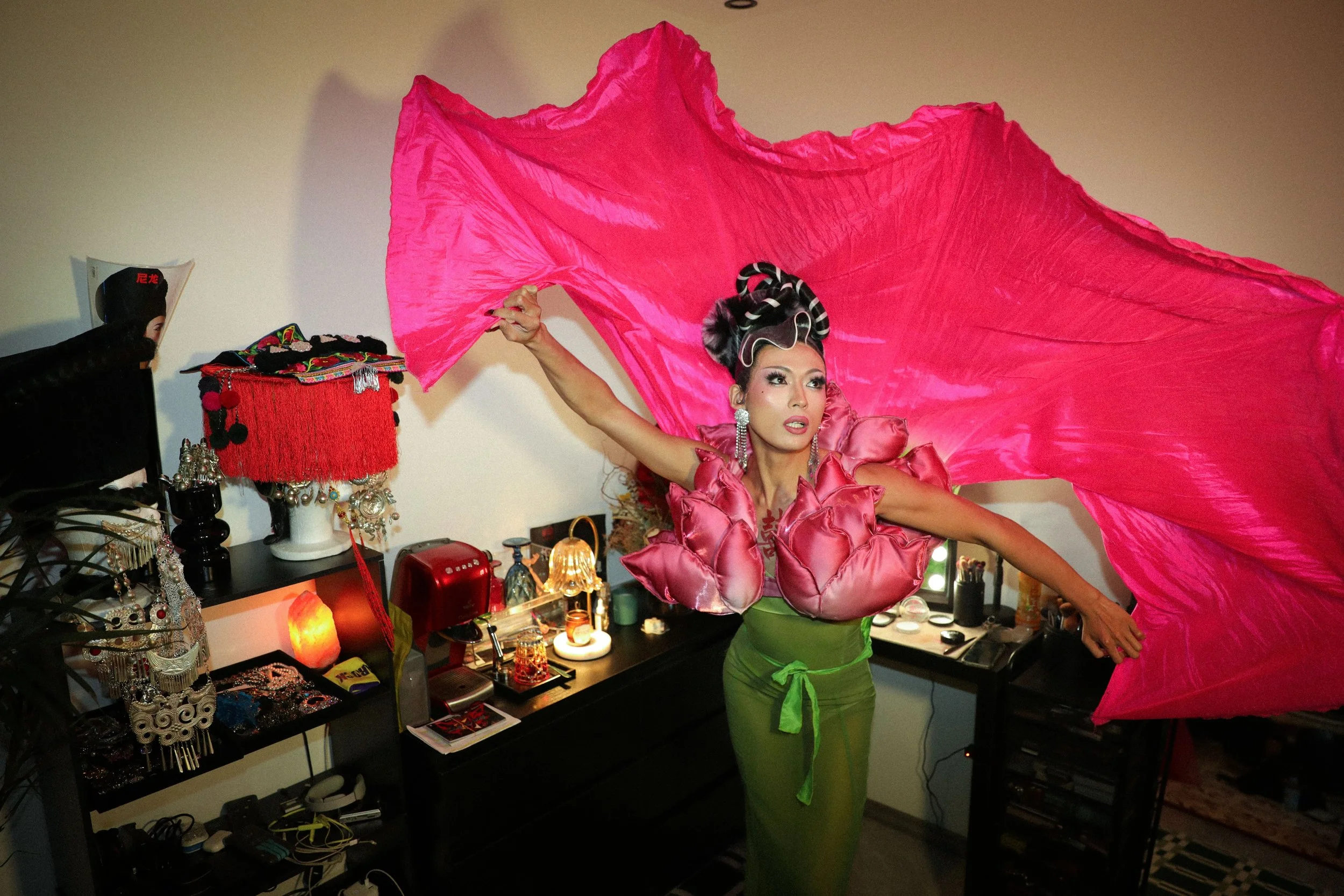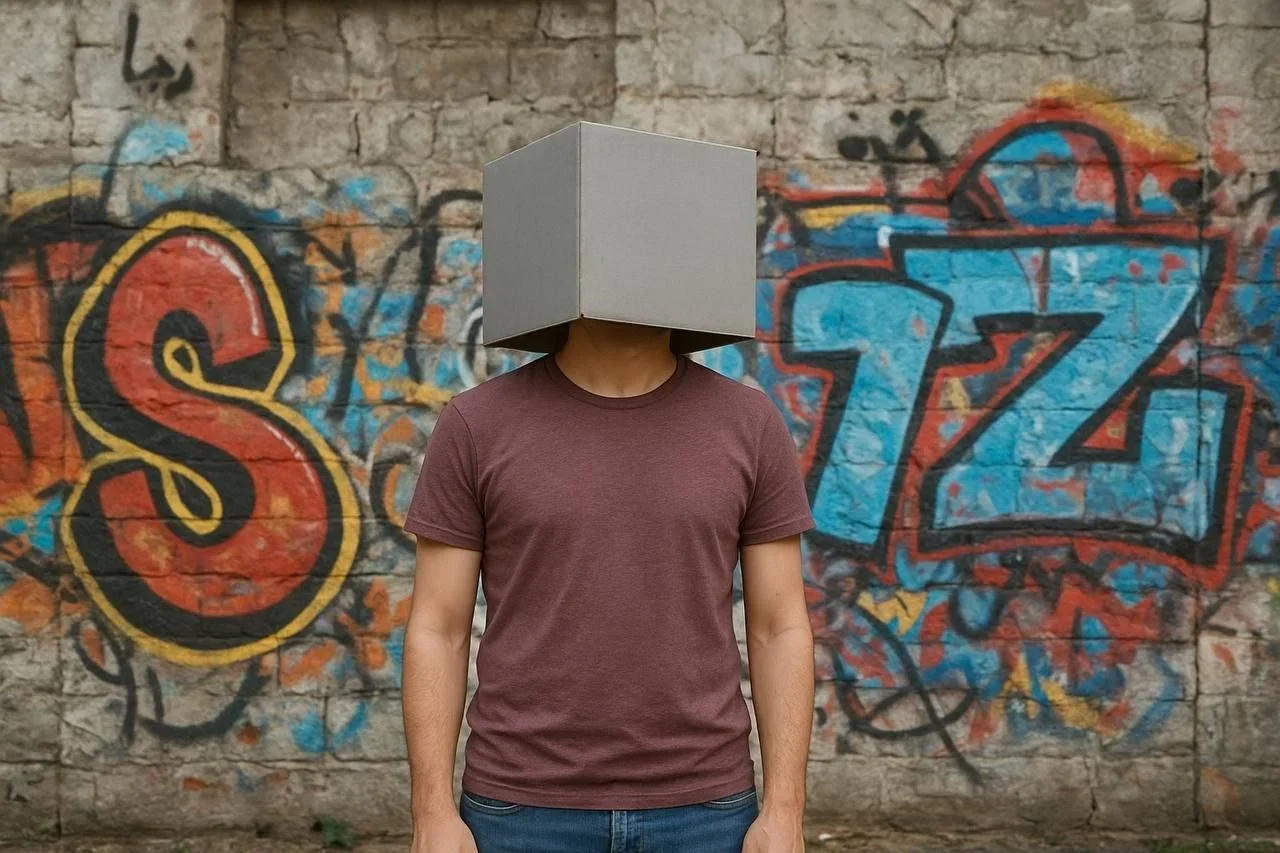10 Questions with Ruonan Shen
Ruonan Shen is a visual artist and photographer based in London. She is currently a student at the University of the Arts London, studying Interior Design. Working primarily with conceptual portraiture, Shen’s practice explores the aesthetics of identity, performance, and visual tension within constructed spaces.
Her recent works engage with gender expression and transformation, focusing on China’s emerging drag scene as a lens through which to question the boundaries of beauty, strength, and self-presentation. Shen creates highly staged environments that balance intimacy and control, presence and absence.
Drawing from minimal aesthetics, theatrical artifice, and emotional ambiguity, Shen’s photographs challenge normative visual codes while inviting moments of stillness and reflection. As an emerging artist, she is interested in photography not as documentation but as reconstruction, a deliberate and quiet act of image-making on their own terms.
Ruonan Shen - Portrait
She | Project Statement
Unleashing Feminine Charm: A Portrait of Chinese Drag Queens
Upon witnessing the dazzling performances on RuPaul’s Drag Race, Ruonan Shen became more resolute than ever to embark on a photographic project that celebrates the performative power of femininity. This body of work centres on the emerging drag queen scene in contemporary China, a space where identity, gender, and expression intersect with complexity and beauty.
The series comprises large-scale environmental portraits that frame each subject within their chosen aesthetic world, elaborate, deliberate, and commanding. These images do not merely document; they amplify the charm, strength, and vulnerability of those who defy conventional binaries.
A guiding thought behind the project is encapsulated in a quote attributed to Wu Zetian, the only female emperor in Chinese history:
“If you put a man in a woman’s position, he will become a woman.”
This statement is not about transformation through costume but about empathy, power, and the fluid nature of roles we are often forced to inhabit. The plight of the marginalized, the struggle for voice and visibility, these are not bound by gender. They are universal. Through this work, Ruonan Shen seeks not to define femininity but to unleash it, in all its theatrical, political, and deeply human forms.
Before wedding © Ruonan Shen
INTERVIEW
Let's start from the basics. Who are you, and how did you first get interested in art?
Hi, I'm Ruonan Shen. I come from China and graduated from the University of the Arts London. I have been passionate about visual arts since childhood, often attending theatre performances and reading art-related books. I believe that my upbringing has had a significant impact on my perspective. Through these readings, I gained insights into the cultural differences between the East and West, as well as their historical transformations.
Around the age of 17, my interest shifted from being an art enthusiast to a desire to create art. I began to engage more seriously with painting and photography, and I developed a stronger focus on contemporary artists from various countries. I strive to stay informed about what is happening in the world and how contemporary art influences people's thoughts and aesthetic values.
Your background is in interior design, yet your artistic focus leans toward conceptual portraiture. How has your design training shaped the way you construct photographic spaces and narratives?
I believe that art and design share many similarities. For instance, creating a good design is much like telling a compelling story or expressing ideas through images. The camera serves as a great starting point; it acts like a canvas where you can place anything.
During the process of photographing portraits, I have the opportunity for direct interaction with the subjects, allowing us to display both our thoughts through imagery. My background and experience in design emphasize the importance of establishing a communicative bridge between the subjects and the viewers in my projects. This communication is not always intimate; I aspire for my work to engage with the audience. Like design, my starting point is to serve those who will use or appreciate the work, aiming to influence a broader audience through my artistic creations.
Drama queen © Ruonan Shen
Why did you choose photography in the first place? What does this medium help you communicate that others don't?
Photography has provided me with insights that other mediums cannot offer, such as composition and light design, the interplay of subjects, colour variations, and scene arrangement. This is a design of storytelling. I'm not particularly good at expressing myself with words, but I find it much easier to convey my thoughts through the lens.
I believe the camera is an extension of our sensory tools. When we view photographs taken by others, no matter how limited, we can grasp their perspective on the world. The way I see the world through my camera results in the world looking back at me in a different way. Sometimes, I struggle to articulate my feelings, and it's challenging to express them in words, but the photograph is always there.
In my philosophy, photography is not just a collection of digital images; it represents significant moments filled with stories and social issues that encourage me to create art. I aim for my work to provoke thought in the audience. I am particularly interested in exploring specific social issues. I believe photography is powerful, and mediums like news media, art galleries, and books can enhance the impact of my work. I aspire to achieve this goal in the future.
As someone who engages with identity and visibility, do you see your photography as a form of activism, empathy, or perhaps something more quietly subversive?
Absolutely. I use photography to expose the truth. In my work, I encountered many Chinese drag artists and formed friendships with them, engaging with their communities and discovering how they express their identities. I feel honoured to capture these highlight moments with my camera. As a part of the LGBTQ community myself, I am acutely aware that these groups are not recognized or protected by law in my country. This topic is not openly discussed in China, and people instinctively ignore and overlook the rights and existence of this community.
I hope to combine my personal experiences with the expressions of my subjects in front of the lens to create images that encourage viewers to reflect and think deeply. The drag queen community illustrates my perspective on the world; escapism and desire are central themes for these performers. Many of their idols have overcome significant adversity. Icons like Lady Gaga and Madonna embody aspirations and resilience, providing a sense of hope for others. This reflects the strength found in these feminine elements, including the feminine symbols represented by these female icons.
Fearless © Ruonan Shen
Under the spotlight © Ruonan Shen
In your recent project, She, you explore China's emerging drag scene through environmental portraits. What initially drew you to this subject, and how did your perspective evolve during the making of the series?
"RuPaul's Drag Race" is an American reality show, and the show's loving motto, "If you don't love yourself, how in the hell you gonna love somebody else," has profoundly influenced my thoughts and perspectives on this social issue. Currently, social movements are receiving more attention and engagement than they have in the past twenty years. For example, during Pride Month, there are varying levels of participation around the world, and even in China, there is increased discussion on these topics. On the surface, it seems that people are more accepting of open discussions about these issues.
However, reality still diverges from ideals, as there remains significant hatred, misunderstanding, and lack of recognition towards the LGBTQ+ community. Only by continuously bringing this topic into the public eye, discussing it openly, and normalizing it can we allow the majority to learn about and understand the realities faced by sexual minorities over time.
This reflects the current social environment where the drag queer community, facing oppression and rejection, has united to support one another. This solidarity illustrates why I am compelled to use my camera to amplify their voices. I plan to extend the scope of this project to include a broader range of queer individuals, using my platform to combat the stigmatization of homosexuality and transgender identities. This is part of my future plans.
Your portraits often balance intimacy and control, presence and absence. Can you share how you approach building trust and collaboration with your sitters, especially in such deeply personal and performative contexts?
Before the shoot, I met with all the subjects multiple times to discuss what kind of effect we wanted to achieve in this project. I believe these discussions are extremely important, as they are a part of the work, and their thoughts matter. Only through thorough communication can the resulting images truly give voice to our ideas.
During the shooting process, I played music for the subjects to perform to, allowing them to fully immerse themselves in the atmosphere. I used flash photography to capture moments that mimic the effects of being on stage, revealing their most authentic selves. This experience was not just a photoshoot; it felt like a deep exchange with them.
Housewife © Ruonan Shen
Theatricality, minimal aesthetics, and emotional ambiguity are recurring elements in your visual language. What artists, movements, or personal experiences have informed this unique blend in your work?
For me, Nan Goldin is my inspiration. Her work, The Ballad of Sexual Dependency, feels more like a visual diary, telling complex and profound interpersonal stories through intimate and raw images of her friendships. Her lens is very close to the subjects, capturing natural environments and genuine emotions. I hope that the images I present can evoke similar thoughts and reactions in viewers, bringing overlooked and undervalued topics to the forefront. Non-heterosexual individuals are among us; they could be anyone around you. I aim not only to destigmatize sexual minorities but also to let others who have suffered know that there are people willing to speak up and fight for them.
As a lesbian from China, I have personally experienced misunderstanding and stigmatization, being labelled as "abnormal" or an "outsider" by traditional societal values. I deeply understand the pain of being unrecognized and the discomfort of people unwilling to confront this reality. To survive or avoid being seen as abnormal, I often had to conceal my identity or deliberately hide. However, after studying abroad, I gradually encountered others who shared similar experiences, which fueled my desire to give voice to our community. This is also a silent cry from me; I hope we can be heard and seen. It is not something to be hidden; it is magnificent and full of dramatic tension.
In a climate where drag culture is both celebrated and challenged globally, how has your work been received, both within the UK and in China? Have you noticed any cultural nuances in audience responses?
In China, I attended their performance competitions, and I was only able to enter because I knew some of the participants. These events were not publicly announced, so they were held in secret. However, due to malicious reports, the police arrived and shut down the competition. One of my queen friends ended up being detained at the police station. In China, these events are not recognized or accepted by the public.
In contrast, I have seen formal performances in the UK, where ticket sales and promotions are conducted openly. This highlights a significant difference for me. Perhaps in the UK, drag queens are seen as something completely normal, and many people have friends from the LGBTQ+ community. I hope that China can gradually transition to this state as well because, ultimately, we are all just human beings.
On stage © Ruonan Shen
Lastly, looking forward, are there other marginalized or underrepresented communities you're interested in exploring through your lens? What themes or questions are currently guiding your next body of work?
In the future, I plan to photograph more Chinese drag queens as well as those from the UK, expanding the scope of this project. For now, I might not consider researching other marginalized groups at the moment, but I would love to expand my project with other groups in the future; I want to focus on completing this current series. This project is still not comprehensive enough, as these images only showcase their appearances after transformation, the versions they want others to see or what they believe strengthens their sense of self.
My next step is to delve deeper into the true essence of drag queens, including the vulnerability they protect within themselves. I aim to strip away the exterior packaging to reveal their inner worlds and everyday realities, such as their jobs, families, and friendships, and to what extent these aspects are influenced by their identities.
Art Review and Critique: The Poetic Power of Performance and Identity in Ruonan Shen’s Photography
By Mohamed BENHADJ | Founder and Art Curator of Al-Tiba9 Contemporary
Ruonan Shen’s photography transcends documentation, becoming a poetic act that reconstructs identity through gesture, setting, and emotional space. As curator of Al-Tiba9 Contemporary, I was amazed by her powerful portrayal of China’s emerging drag scene. Her portraits are carefully staged with full visual tension.
Shen’s background in interior design gives her work a strong sense of space. She treats the photograph like a stage, where every detail, from costume and lighting, is carefully studied. Her design training allows her to control both the look and feel of the image, creating scenes that are both artistically crafted and emotionally moving. The camera becomes a tool to shape not only visual form but also the subtle dynamics between the performer and the viewer.
At the heart of this series is the Chinese drag scene, a space for self-expression and resistance. Inspired by RuPaul’s Drag Race and a quote from Wu Zetian, China’s only female emperor, Shen shows femininity not as imitation but as a powerful, empathetic force. Her portraits avoid stereotypes. Instead, they highlight the strength and the sensitivity of each performer.
In her interview, Shen explains how she builds trust with her subjects through conversation and shared vision. She uses music and flash photography to create an atmosphere where her subjects can be fully themselves. The result is a balance between control and authenticity, staged scenes that still feel deeply real.
The political and emotional urgency of the work is clear. Shen, as a member of the LGBTQ+ community, knows firsthand the risks faced by drag performers in China. Her portraits become acts of solidarity. They highlight the contrast between underground shows in China and more open drag performances in the UK, opening a broader conversation about individual freedom, safety, and cultural differences.
Her work is a form of visual activism. It honors the beauty and the resistance of drag culture while also highlighting the social pressures that threaten it. Her admiration for Nan Goldin shows in her ability to bring raw emotion into public view.
What’s most impressive is how developed Shen’s work is, even though she’s still a student at the University of the Arts London. She connects deeply with her subjects, builds powerful visual stories, and creates photographs that are both artistic and socially meaningful.
Looking forward, Shen plans to go even deeper to explore not just the drag persona but the daily lives, relationships, and inner worlds behind the makeup and performance. This next step will add even more depth to her already strong work.
In short, Ruonan Shen’s photography is a standout debut in contemporary portraiture. Her images are beautifully staged and emotionally impactful. They bring new urgency to conversations about drag, and identity in China. At Al-Tiba9 Contemporary, we are proud to support this bold and thoughtful new voice in queer Chinese art.
Artist’s Talk
Al-Tiba9 Interviews is a curated promotional platform that offers artists the opportunity to articulate their vision and engage with our diverse international readership through insightful, published dialogues. Conducted by Mohamed Benhadj, founder and curator of Al-Tiba9, these interviews spotlight the artists’ creative journeys and introduce their work to the global contemporary art scene.
Through our extensive network of museums, galleries, art professionals, collectors, and art enthusiasts worldwide, Al-Tiba9 Interviews provides a meaningful stage for artists to expand their reach and strengthen their presence in the international art discourse.





















